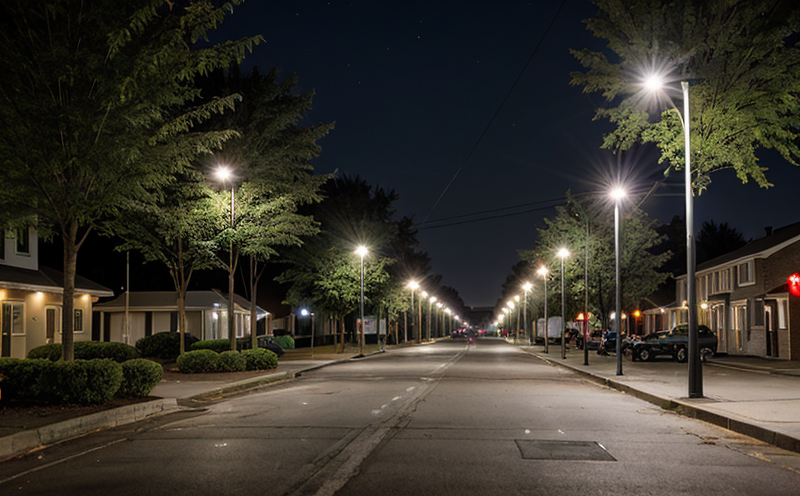ISO 9227 Corrosion Resistance Testing of Outdoor Street Lighting Poles
The ISO 9227 standard is a widely recognized international protocol that provides guidance on determining the corrosion resistance of metallic materials, particularly focusing on outdoor street lighting poles. This service is essential for ensuring compliance with regulatory requirements and enhancing the durability and longevity of street lighting infrastructure.
Outdoor street lighting poles are subjected to harsh environmental conditions such as exposure to salt spray, humidity, temperature fluctuations, and aggressive pollutants. These factors can significantly accelerate corrosion processes, leading to structural weakness and potential failure. The ISO 9227 test is a critical tool in predicting the long-term performance of these components by subjecting them to controlled environments that mimic real-world conditions.
The testing procedure involves immersing the specimens in an accelerated corrosive environment for extended periods. This process allows engineers to assess the effectiveness of protective coatings and materials used in the construction of street lighting poles. The test results provide valuable insights into the expected service life under various climatic and operational conditions, thereby enabling informed decisions regarding material selection and quality control.
The methodology outlined in ISO 9227 is based on salt spray testing (SS) which simulates the corrosive effects of salt-laden air found near coastal areas and urban environments. The test chamber creates an environment with controlled humidity levels, temperature ranges, and a continuous mist of sodium chloride solution to replicate the aggressive conditions that street lighting poles face daily.
During the test, specimens are exposed for predetermined durations, typically ranging from 60 to 180 days depending on the material's expected lifespan. Specimens are inspected periodically throughout the exposure period to monitor the extent and type of corrosion. This allows for precise assessment of degradation levels and identification of weak points in the protective layers.
Once testing is completed, detailed reports are generated that document the progression of corrosion, its severity, and any changes in material properties. These reports serve as critical references for quality managers, compliance officers, R&D engineers, and procurement teams responsible for selecting appropriate materials and coatings for street lighting installations.
- Standard Compliance: ISO 9227 ensures that testing aligns with international standards, enhancing credibility and facilitating global trade.
- Data Accuracy: Rigorous adherence to standardized protocols guarantees accurate and reliable results.
- Material Selection: Provides valuable data for optimizing material selection based on real-world performance expectations.
The service offered by our laboratory is not just about compliance; it's about enhancing the reliability and sustainability of street lighting systems. By leveraging ISO 9227, we can help clients ensure that their infrastructure stands up to challenging environmental conditions, thereby contributing to safer, more efficient urban environments.
Why It Matters
The integrity of outdoor street lighting poles is paramount for ensuring public safety and operational efficiency. Corrosion can lead to structural failures, increased maintenance costs, and reduced performance, ultimately affecting the quality of life in communities. By adhering to ISO 9227 standards, we contribute to the development of robust infrastructure that can withstand environmental challenges.
For quality managers and compliance officers, this service ensures that their projects meet stringent regulatory requirements, thereby avoiding costly rework or non-compliance penalties. R&D engineers benefit from the detailed insights into material performance under simulated real-world conditions, which can guide innovation in protective coatings and materials. Procurement teams gain confidence knowing they are sourcing components that have been rigorously tested for durability and longevity.
The importance of this testing cannot be overstated in an era where sustainability is a key consideration. By extending the service life of street lighting poles, we reduce waste and resource consumption, aligning with broader environmental goals. This not only benefits individual projects but also contributes to global efforts towards sustainability.
International Acceptance and Recognition
- ISO 9227: Widely recognized in the international community for its rigorous testing protocols.
- ASTM: Complementary standards like ASTM B117 are often used in conjunction with ISO 9227.
- EN 16380: European standard that aligns closely with ISO 9227, ensuring compatibility across EU markets.
- IEC: International Electrotechnical Commission standards for electrical and electronic equipment often reference ISO 9227.
The global acceptance of these standards ensures consistent quality assurance practices worldwide. Compliance with ISO 9227 is not only a local requirement but also facilitates seamless international trade, making it an indispensable tool in the design and manufacturing processes for street lighting poles.
Environmental and Sustainability Contributions
The implementation of ISO 9227 testing plays a crucial role in fostering sustainable practices within the lighting industry. By enhancing the durability and longevity of street lighting poles, we contribute to reduced maintenance needs and extended operational periods, which translate into lower environmental impacts.
Extended service life means fewer replacements, reducing waste generation and resource depletion. Additionally, the precise data provided by this testing aids in optimizing material use, further minimizing ecological footprints. For procurement teams, adherence to these standards ensures that they are supporting sustainable practices, aligning with broader corporate sustainability goals.
The ISO 9227 test also supports the development of eco-friendly materials and coatings that can withstand harsh conditions more effectively. This shift towards greener solutions not only benefits individual projects but contributes to larger efforts in promoting a more sustainable built environment.





